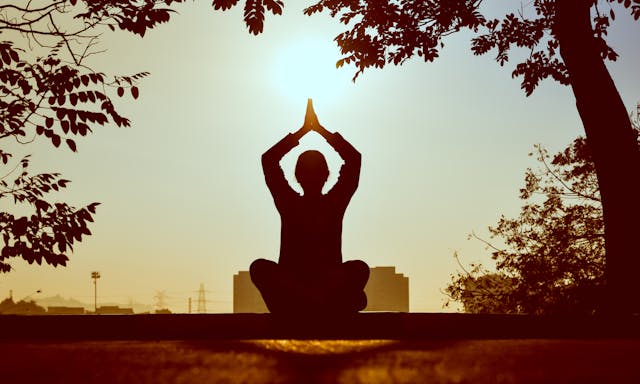
In today’s fast-paced world, it’s easy to get caught up in negative thoughts and emotions.
However, cultivating a sense of gratitude can have a profound impact on our mental and emotional well-being.
Gratitude meditation is a powerful tool that can help us shift our focus from what’s lacking to what we already have.
In this article, we’ll explore three gratitude meditation exercises that can help you cultivate a positive mindset and increase your sense of well-being.
Common Gratitude Meditation Exercises

The 5 Senses Gratitude Meditation
This exercise is designed to help you focus on the present moment and appreciate the beauty in your surroundings.
It’s a great way to slow down and cultivate a sense of gratitude for the simple things in life.
The Exercise
Step 1: Settle into comfort
To embark on this journey of gratitude, find yourself a cozy spot where you won’t be disturbed.
Whether seated or lying down, ensure your body is at ease, allowing yourself to fully relax and embrace the present moment.
Step 2: Focus on sight
Close your eyes if it helps, and let your mind’s eye guide you to something visually enchanting.
It could be the vibrant hues of a blooming flower, the serene landscape outside your window, or the comforting familiarity of a loved one’s face.
Take a moment to immerse yourself in the details, noticing every color, shape, and texture.
Let gratitude bloom within you as you appreciate the beauty before you.
Step 3: Engage your other senses
Now, let’s explore gratitude through the lens of your other senses.
- Hearing: Tune in to the symphony of sounds around you. Perhaps it’s the melodic chirping of birds, the soothing rhythm of rainfall, or the laughter of cherished company. Allow each sound to wash over you, filling you with appreciation for the auditory delights of life.
- Smell: Take a deep breath and inhale the fragrant scents that surround you. Whether it’s the aroma of freshly baked bread, the earthy scent of rain, or the comforting perfume of a loved one, let each breath remind you of the simple joys that perfume the air.
- Taste: Consider the flavors that bring you joy. Whether it’s the sweetness of ripe fruit, the warmth of a comforting meal, or the richness of your favorite beverage, savor each taste as a reminder of the abundance of flavors that enrich your life.
- Touch: Finally, connect with the world through touch. Feel the warmth of sunlight on your skin, the softness of a cozy blanket, or the gentle embrace of a loved one’s hand. Allow yourself to fully experience the tactile sensations that evoke gratitude within you.
Step 4: Cultivate gratitude
With each sense explored, take a moment to reflect on the blessings they bring to your life.
Let gratitude fill your heart as you acknowledge the abundance of beauty and joy that surrounds you.
Allow yourself to bask in the warmth of appreciation for the simple pleasures that enrich your days.
Step 5: Return to the Present
As this gratitude meditation comes to a close, gently bring your awareness back to the present moment.
Wiggle your fingers and toes, take a deep breath, and open your eyes if they were closed.
Carry the spirit of gratitude with you as you continue your journey, knowing that you can always return to this place of appreciation whenever you need.

The Gratitude Chain Meditation
This exercise is designed to help you cultivate a sense of gratitude by focusing on the good things in your life.
It’s a great way to shift your focus from what’s lacking to what you already have.
The exercise
Step 1: Choose your path
Embark on a journey of gratitude either solo or with a partner.
Whether you prefer to reflect inwardly or share the experience with someone else, this meditation offers an opportunity to cultivate appreciation for the abundance in your life.
Step 2: Lay the foundation
Begin by expressing a single statement of gratitude aloud.
It could be as simple as appreciating the warmth of the sun on your skin, the laughter of a friend, or the comfort of a cozy home.
This initial offering sets the stage for the cascade of gratitude to follow.
Step 3: Building the chain
If practicing with a partner, take turns adding to the chain of gratitude.
Each statement builds upon the previous one, creating a tapestry of appreciation.
For example, if your partner expresses gratitude for a beautiful day, you might add appreciation for the gentle breeze that enhances the experience.
If practicing alone, continue the chain of gratitude within your own mind.
With each successive statement, delve deeper into the well of blessings in your life.
Let each expression of gratitude spark the next, creating a seamless flow of appreciation.
Step 4: Savoring the moment
Allow the gratitude chain to unfold organically, either for a set period or until the flow naturally ebbs.
Set a timer for 5-10 minutes to guide your practice, or simply follow the rhythm of gratitude until it feels complete.
As you bask in the glow of appreciation, savor the richness of each moment.
Let the warmth of gratitude wash over you, illuminating the abundance that surrounds you.
Whether alone or with a partner, relish the connection forged through shared expressions of thankfulness.
Step 5: Reflecting on the journey
As the meditation draws to a close, take a moment to reflect on the journey of gratitude you’ve embarked upon.
Notice how each statement of appreciation has woven together to form a vibrant tapestry of blessings.
Feel the warmth of gratitude radiating within you, nurturing your spirit and strengthening your bonds with others.
In this practice of the gratitude chain, may you find joy in the simple act of appreciation and cultivate deeper connections with the world around you.

The Body Scan Gratitude Meditation
This exercise is designed to help you cultivate a sense of gratitude for your physical body.
It’s a great way to appreciate the many ways your body serves you and to release any tension or stress.
The Exercise
Step 1: Settle into comfort
Find a quiet space where you can comfortably sit or lie down.
Take a moment to adjust your posture, allowing your body to relax into a position that feels supportive and restful.
Step 2: Centering with breath
Close your eyes if it feels comfortable, and bring your attention to your breath.
Notice the sensation of air entering and leaving your body, allowing each inhale and exhale to anchor you in the present moment.
Take a few moments to simply be with your breath, letting go of any distractions or worries.
Step 3: Embark on the body scan
Now, begin the gentle journey of the body scan.
Starting from the tips of your toes, slowly shift your awareness to each part of your body, one at a time.
Notice any sensations you may feel in each area, without judgment or expectation.
Move gradually upwards, through your feet, ankles, calves, knees, and thighs.
Continue scanning through your pelvis, abdomen, chest, back, shoulders, arms, hands, neck, and finally, your head.
Step 4: Cultivating gratitude
As you focus on each body part, take a moment to reflect on its function and significance in your life.
Consider the incredible capabilities of your body, from the simplest movements to the most complex processes that keep you alive and thriving.
With each area you scan, silently express gratitude for its role in supporting you.
Whether it’s the strength of your legs that carry you through the day, the dexterity of your hands that allow you to create and connect, or the resilience of your heart that beats steadily within your chest, honor the myriad ways your body serves you.
Step 5: Embracing wholeness
As you complete the body scan, take a moment to appreciate your body as a whole.
Feel a sense of unity and interconnectedness with every part of yourself, recognizing the beauty and intricacy of your physical being.
Allow feelings of gratitude to wash over you, filling you with a profound sense of appreciation for the vessel that houses your essence.
Embrace a deep sense of reverence for your body and all that it enables you to experience in this world.
The Benefits of Gratitude Meditation

Gratitude meditation serves as a beacon of positivity, illuminating the path to improved mental and physical well-being.
Let’s delve deeper into the multifaceted benefits this practice offers.
Enhanced mental health and well-being
Gratitude meditation acts as a salve for the mind, soothing symptoms of anxiety, depression, and stress.
By shifting focus from what’s lacking to what’s present, it cultivates resilience and emotional balance.
Through regular practice, individuals develop a more positive self-perception, fostering a sense of contentment and fulfillment in life.
Strengthened relationships and social connections
Gratitude fosters a ripple effect of kindness and connection in interpersonal relationships.
By expressing gratitude towards others, individuals nurture deeper bonds and create an environment of mutual appreciation.
This cycle of reciprocity strengthens empathy, understanding, and trust, laying the foundation for more rewarding and fulfilling relationships.
Improved brain function and physical health
Gratitude meditation is a catalyst for brain activation, particularly in the prefrontal cortex, the seat of positive emotions.
The practice stimulates the release of neurotransmitters like dopamine and serotonin, which are essential for promoting feelings of happiness and well-being.
Moreover, by cultivating a positive mindset, gratitude meditation contributes to overall physical health and vitality.
Enhanced sleep quality and stress reduction
The calming effects of gratitude meditation extend beyond waking hours, positively impacting sleep quality and stress levels.
By fostering a state of relaxation and tranquility, it promotes restful sleep and mitigates the effects of stress-related disorders.
As individuals embrace gratitude, they find themselves drifting into a peaceful slumber, free from the burden of worry and tension.
Fostering trust and empathy
Gratitude meditation acts as a bridge, fostering trust and empathy in both personal and social contexts.
By cultivating a deep sense of appreciation for others’ contributions, individuals develop a greater sense of connection and understanding.
This heightened empathy allows for more meaningful interactions, paving the way for a more harmonious and compassionate world.
Conclusion
Gratitude meditation is a powerful tool that can help you cultivate a positive mindset and increase your sense of well-being.
By focusing on the present moment and appreciating the good things in your life, you can shift your focus from what’s lacking to what you already have.
Try incorporating these exercises into your daily routine and see the positive impact they can have on your life.
FAQs
Aim to practice gratitude meditation at least 3-4 times a week, but ideally every day. Even a few minutes a day can make a significant difference in your mental and emotional well-being.
Start small. Begin by focusing on the simple things in your life, like a good cup of coffee or a beautiful sunset. As you practice, you’ll find that your list of things to be grateful for grows.
Absolutely. Feel free to modify these exercises to fit your needs and preferences. For example, you might want to add music or guided imagery to enhance your experience.


